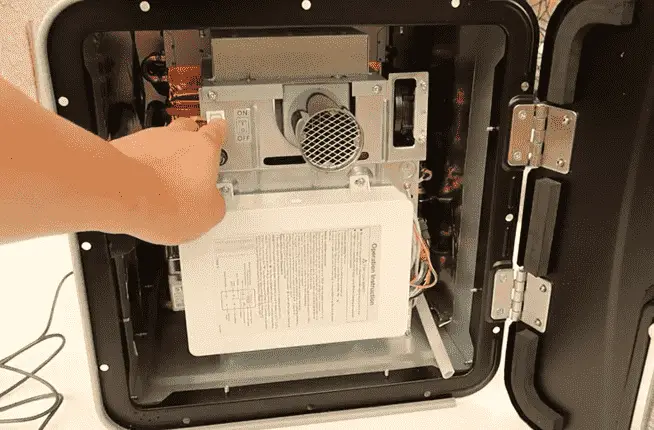Does your RV water heater lights then goes out? This problem is generally caused by a blown thermal fuse, dirty tube, clogged burner orifice, busted thermocouple, and a faulty circuit board.
Keep reading this article to learn more about this problem and the solutions that you can implement to fix this issue right away.
Table Of Contents
- RV Water Heater Lights Then Goes Out [5 Easy Fixes]
- 1. Blown Thermal Fuse
- 2. Dirty Tube
- 3. Clogged Burner Orifice
- 4. Busted Thermocouple
- 5. Faulty Control Board
- How To Maintain Your RV Water Heater?
- How To Manually Light A RV Hot Water Heater?
- FAQs:
- Can I leave my RV water heater on all the time?
- Will your RV water heater freeze in cold weather?
- How long does it take for an RV Water Heater to heat water?
- Why does my RV water heater make a roaring noise?
- Conclusion
RV Water Heater Lights Then Goes Out [5 Easy Fixes]
Why won’t my RV heater light? We’ll explain the most common reasons why your RV heater keeps shutting off in this section.
1. Blown Thermal Fuse
The thermal fuse is a safety mechanism that protects the heater from being overheated and prevents a fire accident. If the temperature reaches over 140 degrees, the thermal fuse gets blown.
The thermal fuse won’t work properly if there is dirt inside it. The ends of the fuse will be black or dirty and you can see if this is causing the problem by taking a look at it.
Solution:
If the thermal fuse is dirty, a good idea is to take a multimeter and see if the fuse has good continuity. If you don’t hear a strong beep, you should clean the thermal fuse with sandpaper and remove the dirt.
In case of a blown-out fuse, you don’t have any other option but to replace it. These fuses get blown from time to time. So, having a few spare ones with you will always come in handy if it gets blown.
2. Dirty Tube
The tube in the heater passes the gas from the gas valve to the ignitor. If there is a build-up of dirt, dust, or cobwebs in this tube, the gas won’t be able to pass easily to the ignitor.
Look for cracks in the tube and see if the distance between the sparker and the grounding rod is okay. With the continued use of the heater, these things can change their position and keep the heater from lighting properly.
Solution:
It’s important to make sure that the tube always stays clean. You’d need a socket to unscrew the tube since it’s placed tightly on the heater. Take it apart and clean it using sandpaper.
If the position of the sparker and the grounding rod has changed, adjust it using a hammer. Beat it gently with a hammer until you get it back close to its original position.
3. Clogged Burner Orifice
The propane gas passes directly through the burner orifice before it ignites. If this orifice is clogged, the gas won’t pass and the pilot light won’t light up.
If it’s slightly clogged, the pilot will light but it’ll eventually shut off because it won’t have good continuity of supply of gas.
Solution:
You’d have to unscrew the screw that’s in front of the orifice to access it and clean it. This burner orifice is made of brass and you want to be gentle when you’re cleaning it.
Use compressed air and blow it into the burner orifice to clean it. That’ll get rid of the dirt and debris that has built up in the orifice. Don’t put any objects in the burner office as it’ll most likely damage the orifice for good.
4. Busted Thermocouple
The heater not staying lit can be caused by a damaged RV water heater thermocouple. The thermocouple assists the pilot light and keeps the gas from going out into the atmosphere.
If dirt accumulates in the thermocouple, it won’t get a sufficient flame, and turn off the heater. The heater will automatically shut off if the thermocouple isn’t able to detect flame. The thermocouple is always exposed to heat and it can get worn out with time.
Solution:
The first thing to check is if the thermocouple is in the correct position. If it’s not in the correct position, it has to be adjusted. It won’t be able to detect the heat if it’s in the wrong position.
Then, you should check if it’s dirty or broken. If there is soot buildup in the thermocouple, clean it and see if it works. If it’s broken, the thermocouple needs to be replaced.
5. Faulty Control Board
RV water heater lights but won’t stay lit? The problem is your heater control board. The brain of the heater is the control board and it manages the functions of the heater.
If your RV heater turns on and then off, it’s because the control board isn’t sensing the flame. That could be because the control board has gone bad or the other problems mentioned in this guide.
Solution:
Unfortunately, this problem doesn’t have a DIY solution. You’d have to call in a technician who knows the technicality of working with RV heaters. If you don’t have expertise in this area, it’s best to stay away from it.
The parts of the RV water heater can get extremely hot and that’s why you shouldn’t attempt to do this yourself. It’s better to be safe than burn your hand to save a few bucks.
How To Maintain Your RV Water Heater?
Most issues with the RV water heater take place because of the formation of dirt and debris in it. Insects and bugs can also get to the heater and cause problems. But with proper maintenance, you’ll be able to avoid these problems.
You should clean your RV water heater at least once a year. Ignoring this will lead to the formation of dirt. Here are the things you should keep in mind to maintain your RV heater:
- You should have to keep the heater tank full before on.
- Clean the inside of the heater with a cloth and remove the common instructions like cobwebs and dirt.
- Never drain the water heater when the heater is hot or has pressure.
- Check if debris has built up in the different components and clean them.
- Flush the tank once a year to get rid of the sediments in the tank.
How To Manually Light A RV Hot Water Heater?
The newer models of RV water heaters have an automatic pilot and you don’t need to do anything to light it up. But for the older models, there are some steps you need to follow to turn on the pilot light. These are:
- Make sure that you have a supply of propane gas.
- Open the panel cover and locate the control knob.
- Turn the knob to the “pilot” position and press it.
- Light the pilot with a lighter or match while you hold down the knob.
- You should see the flame once it lits up.
- Release the knob once you see the flame and keep it at the “on” position.
If you’re wondering how I light the pilot on my RV water heater, now you know the answer. It’s easy to do if you know the steps and you’ll have no issues after doing it a few times.
FAQs:
Can I leave my RV water heater on all the time?
It’s safe to keep on all the time your RV water heater. But it’ll be a little more expensive if you leave it on all the time. The upside is that you won’t have to wait for hot water anymore.
Will your RV water heater freeze in cold weather?
The RV water heater will freeze during the winter if the tank is filled with water. Even the pipes of the heater will be frozen if the temperature stays under the freezing point for 24 hours.
How long does it take for an RV Water Heater to heat water?
It depends on the quantity of water. For example, the RV water heater will heat up 5 gallons of water faster than 10 gallons of water. But in general, you should get hot water within 15 to 20 minutes.
Why does my RV water heater make a roaring noise?
Your RV water heater will make a strong sound if the supply of gas is too much. You can easily adjust the flow of air by unscrewing the adjuster and sliding it to decrease the airflow to the ignitor.
Conclusion
It’s frustrating if your water heater doesn’t work properly. But now you know the reasons why your RV water heater lights then goes out and how you can solve these issues and get your heater up and running again.
We hope the tips shared in this article will be useful to you and you can fix the problem with your RV water heater. Leave a comment below if you have any questions!
Note: You can also read how to fix the Pentair heater not turning on problem.

